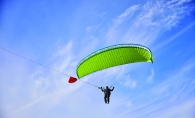
You have to wonder if there’s something in the water—Lake Minnetonka’s water, perhaps?—because Minnesota has been home to an especially impressive number of Olympic athletes. Of course, hockey has played a major role in our state’s reputation for sport dominance, from the 1980 “Miracle on Ice” hockey team to state icon Herb Brooks, who played on more U.S. national and Olympic teams between 1960 and 1970 than any other player in history. More recently, there’s Lindsey Vonn, the most successful American ski racer in history, named by the U.S. Olympic Committee as the Sportswoman of the Year in 2010.
While these “Olympisotans” are the stuff of statewide legend, there are so many other accomplished Olympians whose stories you might not have heard. In our warmup for the games in Pyeongchang, which kick off this month, two lake-area natives share their tales of Olympic adventures.
Bob Kempainen: U.S. Marathoner, 1992 and 1996
Kempainen grew up in Minnetonka, in the original Minnetonka Mills neighborhood, and now lives in St. Paul.
Minnesota has a rich history of Olympian long-distance runners, from Leonard “Buddy” Edeline in 1964 to Steve Plasencia in 1988 and 1992. Bob Kempainen, 51, who grew up near the Charles H. Burwell House in Minnetonka Mills, continued that tradition. “I had older brothers who ran, and I started running in junior high,” he says. “I remember especially loving the trail in Big Willow Park, and I occasionally still do a loop there when I’m out for a run.”
Kempainen competed at Hopkins High School and Dartmouth College, where he graduated with a degree in biochemistry. He took a year off from his studies at the medical school of the University of Minnesota in order to train for the 1992 Olympics in Barcelona. He also competed in the Atlanta games in 1996. He is pragmatic about his participation and performance. “Everyone stepping to the starting line dreams of winning an Olympic medal, and so even if you have a great race, it is often a bit of a letdown” if you don’t win, he says. “I was fortunate to be able to take a crack at a medal twice, and even though neither race came together as well as I had hoped, it was a great experience.”
He thinks Minnesota’s culture of Olympic achievement might have something to do with all the great athletes who have gone before. “Precedent really does matter, and I looked up to the other great distance runners who had gone ahead of me,” Kempainen says. He mentions Dick Beardsley, whose finish time at the 1981 Grandma’s Marathon in Duluth was a course record for 33 years, and who had a famous close second-place finish with Alberto Salazar in the 1982 Boston Marathon. “Other famous runners, like Garry Brian Bjorklund, Mark Nenow and Steve Plasencia, are part of our ‘running culture’ here,” he says.
Kempainen is a pulmonologist and critical care physician at Hennepin County Medical Center. These days, he says, “I might run 20 miles a week, just to blow off steam.” While he and his wife, Sarah, live in St. Paul, he still makes it home to Minnetonka Mills to visit his mother, and he often takes time out for a run with her dog when he’s there. “I don’t run competitively anymore, and I don’t have a desire to,” he says. “I’d rather take it a little bit easier and have more years I can run. There are a lot of miles on my odometer right now.”
Jack Morrison: U.S. Olympic Hockey Team, 1968
Morrison grew up in Long Lake and now lives in Wayzata.
He didn’t even own a hockey uniform until he made the high school hockey team, but Jack Morrison grew up with a stick in his hand, playing pickup hockey near his home on Long Lake. “From the time I was 4 or 5, I’d go down to the pond and play hockey with my buddies,” he says. His love for the game continued during his years at The Blake School, Phillips Academy Andover and Yale University, where he was named an All-American his senior year. In the summer of 1967, he was tapped by coach Murray Williamson to play on the Olympic team for the games in Grenoble, France. The team tied for fourth place. “It was disappointing, but it was an honor just to represent my country,” Morrison says.
After graduating from Harvard Business School, Morrison worked around the globe and was a longtime Pillsbury employee. He moved his family to Wayzata in 1981. “We lived up on the hill, near the Wayzata Community Church, for more than 30 years,” he says. He and his wife of 50 years, Chris, recently moved to a townhome in the heart of Wayzata. “We just turn the key and leave, with no worries about leaf-raking or snow-blowing. We love it,” he says.
Morrison, 72, still plays pickup hockey at least once a week. “Our team ranges in age from 55 to 80, and while we were all fairly decent back in the day, we’re a lot slower now,” he says, smiling. “Our biggest issue is figuring out who’ll bring the beer next time.”
His connections to the Lake Minnetonka area remain strong. “My family has been in the area since 1850, and my dad grew up on Lake Minnetonka,” he says. His favorite memories revolve around the lake, he says, “waterskiing with friends in summer and playing pickup hockey games on the ponds in winter.” He and Chris can often be found walking to a local coffee shop in the morning, or dining at some of their favorite spots, including Sushi Fix, Bellecour, McCormick’s Irish Pub and Gianni’s Steakhouse. “There’s a lot to like about living near lower Lake Minnetonka. Wayzata is a friendly and charming village, and we feel fortunate to live there,” he says.
Minnesota Gold
Author Patrick Mader says there’s something special about Minnesotan Olympians. “There’s a Midwest work ethic and attitude they seem to share,” he says. “Almost without exception, they give back and volunteer to the community and to their sport.”
Mader says he wrote Minnesota Gold: Conversations with Northland Athletes Competing on the World Stage, which includes interviews with 57 Minnesotan Olympic athletes, because he wanted to preserve these stories, especially those of early, pre-television Olympians, before it was too late. “I talked to people who competed between 1948 and 2014,” he says. “They have such inspirational stories, because almost all of them overcame some adversity—personal tragedy, injury or accident—and managed to go on and compete on the world stage.”
He’s currently working on a new book of “Olympisotan” interviews, scheduled to be published December 2019. Find a copy of Minnesota Gold at the website here.









